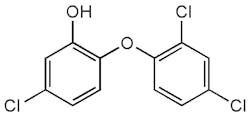The Triclosan Controversy: What are the facts?
Over the last few years, the chemical known as triclosan has come under scrutiny as potentially harmful. Type the word “triclosan” into an internet search and a large number of websites appear, including attorneys eager to file lawsuits and alarming accounts from people who claim this common ingredient causes all kinds of human disease. Should we be concerned? Are the alarmists correct? What does the evidence say?
According to the United States Environmental Protection Agency, triclosan is an antimicrobial active ingredient contained in a variety of products where it acts to slow or stop the growth of bacteria, fungi, and mildew. There are currently 20 antimicrobial registrations, which EPA regulates under the Federal Insecticide, Fungicide, and Rodenticide Act (FIFRA).
Triclosan can be found in a variety of over-the-counter products, such as soaps, toothpastes, and make-up. It also has a number of commercial uses, such as in a small number of pesticides, in conveyor belts, fire hoses, dye bath vats, or ice-making equipment as an antimicrobial pesticide. Triclosan can be directly applied to commercial HVAC coils, where it prevents microbial growth. As a material preservative, triclosan is used in many products including adhesives, fabrics, vinyl, plastics (toys, toothbrushes), polyethylene, polyurethane, polypropylene, floor wax emulsions, textiles (footwear, clothing), caulking compounds, sealants, rubber, carpeting, and a wide variety of other products.
The question of safety and efficacy of triclosan in toothpaste recently prompted the Cochrane Collaboration to conduct a systematic review of the data. Established as a non-profit international organization in 1993, the aim of the Cochrane Collaboration is to help people make well-informed decisions about healthcare. In fact, Cochrane reviews are now considered the “Gold Standard” for systematic reviews. The Cochrane Libraryis a collection of six databases that contain different types of high-quality, independent evidence to inform healthcare decision-making. Cochrane Systematic Reviews are globally recognized by health professionals as the authority for high quality clinical decision-making.
The objective of the Cochrane systematic review was to assess the effects of triclosan/copolymer-containing fluoride toothpastes, compared with fluoride toothpastes, for the long-term control of caries, plaque and gingivitis in children and adults. The review analyzed 30 studies containing 14,835 subjects that were published between 1990 and 2012.
The systematic review, published in 2013, showed that significant oral health benefits result from using a triclosan/copolymer fluoride toothpaste when compared to the benefits of using a toothpaste with fluoride alone (without triclosan/copolymer). There was a 22% reduction in plaque, a 22% reduction in gingivitis, and a 48% reduction in bleeding gums. Further, there was no evidence of any harmful effects associated with the use of triclosan/copolymer toothpastes in studies up to three years in length. The conclusion is that the use of a toothpaste with triclosan/copolymer provides a low cost prevention solution for early stage gingival disease.
The United States Food and Drug Administration, which regulates many consumer products for safety, has published that “there is clear evidence that triclosan provides a benefit. In 1997, the FDA reviewed extensive effectiveness data on triclosan in Colgate Total toothpaste. The evidence showed that triclosan in this product was effective in preventing gingivitis.”
The FDA website lists some things consumers should know:
- Triclosan is not known to be hazardous to humans.
- The FDA does not have sufficient safety evidence to recommend changing consumer use of products that contain triclosan at this time.
- In light of questions raised by recent animal studies of triclosan, FDA is reviewing all of the available evidence on this ingredient’s safety in consumer products.
- At this time, FDA does not have evidence that triclosan added to antibacterial soaps and body washes provides extra health benefits over soap and water. Consumers concerned about using hand and body soaps with triclosan should wash with regular soap and water.
- Consumers can check product labels to find out whether products contain triclosan.
In conclusion, the available evidence from the latest Cochrane Collaboration and the FDA confirm the safety and efficacy of triclosan/copolymer toothpastes. Dental professionals should rely on high-quality evidence for their decision-making in recommending safe and efficacious products for their patients.
_________________________
Dianne Glasscoe Watterson, RDH, MBA, is an international speaker, consultant, and author with more than four decades in dentistry. She has published two books, several textbook chapters and authored hundreds of articles for dental professionals. Her website is www.professionaldentalmgmt.com.
Other articles by Watterson
- Follow-up after definitive therapy
- Legal Questions About Employment
- When should a dental office refer to a periodontist?
-------------------------------------------------------------



